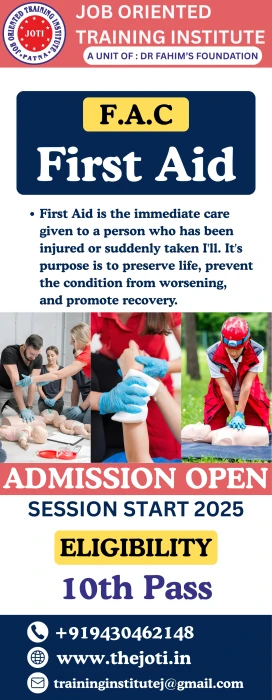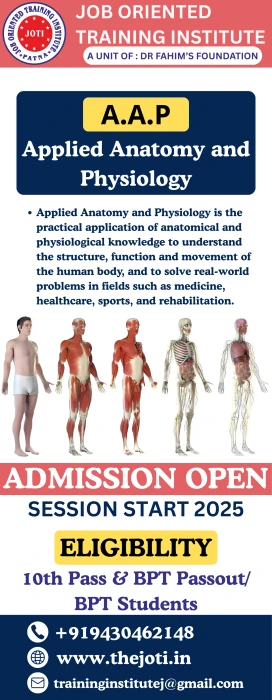 Near AIIMS Phulwari Sharif Patna
Near AIIMS Phulwari Sharif Patna [email protected]
[email protected] 7369848448
7369848448

The scope of First Aid for medical students includes:
1. Patient assessment and triage
2. Wound management (cleaning, dressing, suturing, stapling)
3. Bleeding control (tourniquets, pressure points)
4. Recognition and treatment of shock
5. Musculoskeletal injuries (sprains, strains, fractures, dislocations)
6. Medical emergencies (cardiac arrest, CPR, stroke, TIA, seizures)
7. Environmental injuries (burns, cold-related illnesses, heat-related illnesses)
8. Pediatric and geriatric first aid
9. First aid in special situations (wilderness, mass casualty, disaster response)
10. Basic life support skills (CPR, defibrillation)
11. Use of first aid equipment (stretchers, splints, bandages)
12. Communication and teamwork in emergency situations
13. Documentation and reporting of first aid incidents
14. Review of first aid kits and equipment
15. Preparation for clinical rotations and practice.
By mastering First Aid, medical students will be able to:
- Provide immediate care and treatment for various injuries and illnesses
- Stabilize patients and prepare them for transport or further medical care
- Work effectively in emergency situations as part of a healthcare team
- Communicate clearly and document first aid incidents accurately
- Demonstrate basic life support skills and use of first aid equipment
- Apply first aid principles in a variety of clinical settings.
Course Description: This course covers the principles and practices of first aid, including patient assessment, wound management, and treatment of various injuries and illnesses. Course Outline: Module 1: Introduction to First Aid - Definition and importance of first aid - First aid kit and equipment - Patient assessment and triage Module 2: Wound Management - Types of wounds (cuts, lacerations, abrasions, etc.) - Wound cleaning and dressing - Suturing and stapling Module 3: Bleeding and Shock - Types of bleeding (arterial, venous, capillary) - Control of bleeding (tourniquets, pressure points, etc.) - Recognition and treatment of shock Module 4: musculoskeletal Injuries - Sprains and strains - Fractures and dislocations - Head and spine injuries Module 5: Medical Emergencies - Cardiac arrest and CPR - Stroke and TIA - Seizures and epilepsy Module 6: Environmental Injuries - Burns (thermal, electrical, chemical) - Cold-related illnesses (hypothermia, frostbite) - Heat-related illnesses (heat exhaustion, heat stroke) Module 7: Pediatric and Geriatric First Aid - Special considerations for children and older adults - Pediatric and geriatric assessment and treatment Module 8: First Aid in Special Situations - First aid in the wilderness - First aid in mass casualty situations - First aid in disaster response Assessment: - Written exams (40%) - Practical exams (30%) - Group projects and presentations (20%) - Participation and attendance (10%)
This course will develop your potential and confidence.
Cupping Therapy (CT) is an ancient method and currently used in the treatment of a broad range of medical conditions. Nonetheless the mechanism of action of (CT) is not fully understood. This review aimed to identify possible mechanisms of action of (CT) from modern medicine perspective and offer possible explanations of its effects. English literature in PubMed, Cochrane Library and Google Scholar was searched using key words. Only 223 articles identified, 149 records screened, and 74 articles excluded for irrelevancy. Only 75 full-text articles were assessed for eligibility, included studies in this review were 64. Six theories have been suggested to explain the effects produced by cupping therapy. Pain reduction and changes in biomechanical properties of the skin could be explained by “Pain-Gate Theory”, “Diffuse Noxious Inhibitory Controls” and “Reflex zone theory”. Muscle relaxation, changes in local tissue structures and increase in blood circulation might be explained by “Nitric Oxide theory”. Immunological effects and hormonal adjustments might be attributed to “Activation of immune system theory”. Releasing of toxins and removal of wastes and heavy metals might be explained by “Blood Detoxification Theory”. These theories may overlap or work interchangeably to produce various therapeutic effects in specific ailments and diseases.
Anatomy
Physiology
Yin and Yang
Cupping Technique
Case Studies

Course Description: This course is designed to provide medical students with a comprehensive understanding of the human body's structure and function, with an emphasis on applying anatomical and physiological knowledge to clinical practice. Course Outline: Module 1: Introduction to Anatomy and Physiology - Overview of anatomy and physiology - Importance of anatomy and physiology in medicine - Basic concepts and terminology Module 2: Musculoskeletal System - Bones and joints - Muscles and movements - Anatomy and physiology of the musculoskeletal system - Clinical applications and case studies Module 3: Nervous System - Brain and spinal cord - Nerves and sensory systems - Anatomy and physiology of the nervous system - Clinical applications and case studies Module 4: Circulatory System - Heart and blood vessels - Blood pressure and circulation - Anatomy and physiology of the circulatory system - Clinical applications and case studies Module 5: Respiratory System - Lungs and airways - Breathing mechanisms and respiration - Anatomy and physiology of the respiratory system - Clinical applications and case studies Module 6: Digestive System - Mouth, esophagus, stomach, small intestine, and large intestine - Anatomy and physiology of the digestive system - Clinical applications and case studies Module 7: Integumentary System - Skin, hair, nails, and related glands - Anatomy and physiology of the integumentary system - Clinical applications and case studies Module 8: Applied Anatomy and Physiology - Case studies and clinical applications - Integration of anatomical and physiological knowledge - Problem-solving and critical thinking Assessment: - Written exams (40%) - Practical exams (30%) - Group projects and presentations (20%) - Clinical case studies and discussions (10%)